by Eric Meier
When attempting to identify a wood sample, it’s important to keep in mind the limitations and obstacles that are present in our task. Before starting, please have a look at The Truth Behind Wood Identification to approach the task in a proper mindset; I consider the linked article to be required reading for all those visiting my site with the intent of identifying wood.
1. Confirm it is actually solid wood.
Before proceeding too much farther into the remaining steps, it’s first necessary to confirm that the material in question is actually a solid piece of wood, and not a man-made composite or piece of plastic made to imitate wood.
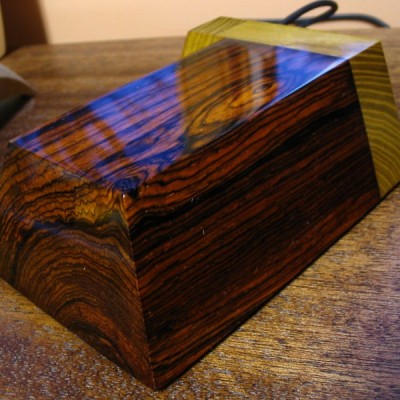
Can you see the end-grain?
Manufactured wood such as MDF, OSB, and particleboard all have a distinct look that is—in nearly all cases—easily distinguishable from the endgrain of real wood. Look for growth rings—formed by the yearly growth of a tree—which will be a dead-giveaway that the wood sample in question is a solid, genuine chunk of wood taken from a tree.
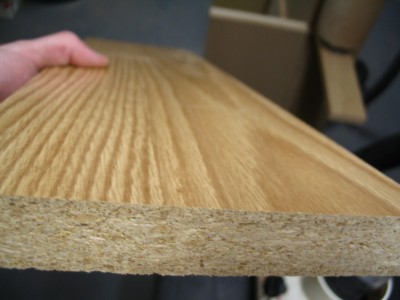
Is it veneered?
If you see a large panel that has a repeating grain pattern, it may be a veneer. In such cases, a very thin layer of real wood is peeled from a tree and attached to a substrate; sometimes the veneer can be one continuous repeating piece because it is rotary-sliced to shave off the veneer layer as the tree trunk is spun by machines. Assuming it is a real wood veneer with a distinct grain and texture—and not merely a piece of printed plastic—you may still be able to identify the outer veneer wood in question, but you should still realize that is it only a veneer and not a solid piece of wood.
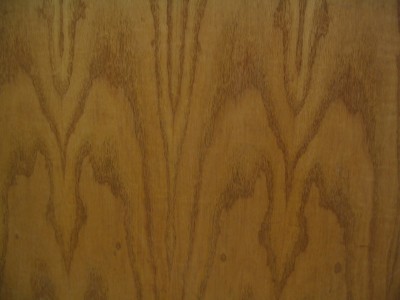
Is it painted or printed to look like wood?
Many times, especially on medium to large-sized flat panels for furniture, a piece of particleboard or MDF is either laminated with a piece of wood-colored plastic, or simply painted to look like wood grain. Many of today’s interior hardwood flooring planks are good examples of these pseudo-wood products: they are essentially a man-made material made of sawdust, glues, resins, and durable plastics.
2. Look at the color.
Some questions to immediately ask yourself:
Is the color of the wood natural, or is it stained?
If there is even a chance that the color isn’t natural, the odds are increased that the entire effort of identifying the wood will be in vain.
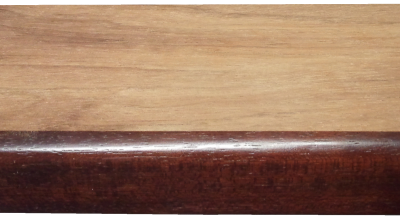
Is it weathered or have a patina?
Many woods, when left outside in the elements, tend to turn a bland gray color. Also, even interior wood also takes on a patina as it ages: some woods get darker, or redder, and some even get lighter or lose their color; but for the most part, wood tends to darken with age.
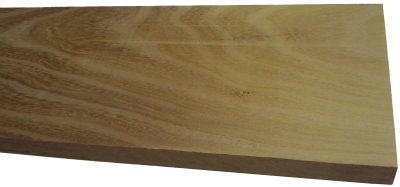
Is it possible to sand or plane the board to see the natural raw color of the wood?
The most predictable baseline to use when identifying wood is in a freshly sanded state. This eliminates the chances of a stain or natural aging skewing the color diagnosis of the wood.
3. Observe the wood grain.
If the wood is unfinished, then look at the texture of the grain. Ask yourself these questions:
Does the wood have an open, porous texture?
Most softwoods will be almost perfectly smooth with no grain indentations, while many common hardwoods have an open pore structure, such as oak or mahogany; though there are some hardwoods that are also smooth to the touch, such as maple.
Can you tell if the wood is quartersawn or plainsawn?
By observing the grain patterns, many times you can tell how the board was cut from the tree. Some wood species have dramatically different grain patterns from plainsawn to quartersawn surfaces. For instance, on their quartersawn surfaces, lacewood has large lace patterns, oak has flecks, and maple has the characteristic “butcher block” appearance.
Is there any figure or unusual characteristics, such as sapwood, curly or wild grain, burl/knots, etc.?
Some species of wood have figure that is much more common than in other species: for example, curly figure is fairly common in soft maple, and the curls are usually well-pronounced and close together. Yet when birch or cherry has a curly grain, it is more often much less pronounced, and the curls are spaced farther apart.
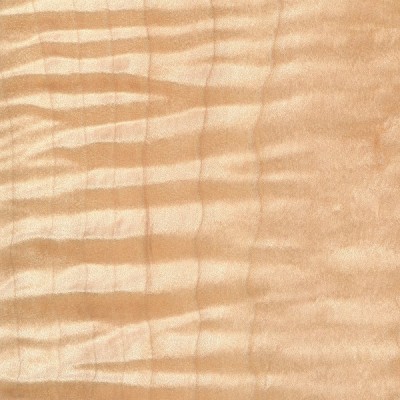
4. Consider the weight and hardness of the wood.
If it’s possible, pick the piece of wood up and get a sense of its weight, and compare it to other known wood species. Try gouging the edge with your fingernail to get a sense of its hardness. If you have a scale, you can take measurements of the length, width, and thickness of the wood, and combine them to find the density of the wood. This can be helpful to compare to other density readings found in the database. When examining the wood in question, compare it to other known wood species, and ask yourself these questions:
Is the wood dry?
Wood from freshly felled trees, or wood that has been stored in an extremely humid environment will have very high moisture contents. In some freshly sawn pieces, moisture could account for over half of the wood’s total weight! Likewise, wood that has been stored in extremely dry conditions of less than 25% relative humidity will most likely feel lighter than average.
How does the wood’s weight compare to other species?
Taking into account the size of the board, how does its weight compare to other benchmark woods? Is it heavier than oak? Is it lighter than pine? Look at the weight numbers for a few wood species that are close to yours, and get a ballpark estimate of its weight.
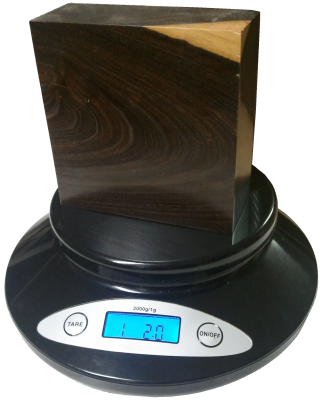
How hard is the wood?
Obviously softwoods will tend to be softer than hardwoods, but try to get a sense of how it compares to other known woods. Density and hardness are closely related, so if the wood is heavy, it will most likely be hard too. If the wood is a part of a finished item that you can’t adequately weigh, you might be able to test the hardness by gouging it in an inconspicuous area. Also, if it is used in a piece of furniture, such as a tabletop, a general idea of its hardness can be assessed by the number and depth of the gouges/dings in the piece given its age and use. A tabletop made of pine will have much deeper dents than a tabletop made of Oak. Additionally, you can always try the “fingernail test” as a rough hardness indicator: find a crisp edge of the wood, and with your fingernail try to push in as hard as you can and see if you’re able to make a dent in the wood.
5. Consider its history.
Many times we forget common sense and logic when attempting to identify wood. If you’ve got a piece of Amish furniture from Pennsylvania, chances are more likely that the wood will be made of something like black walnut or cherry, and not African wenge or jatoba. You might call it “wood profiling,” but sometimes it can pay to be a little prejudiced when it comes to wood identification. Some common-sense questions to ask yourself when trying to identify a piece of wood:
Where did it come from?
Knowing as much as you can about the source of the wood—even the smallest details—can be helpful. If the wood came from a wood pile or a lumber mill where all the pieces were from trees processed locally, then the potential species are immediately limited. If the wood came from a builder of antique furniture, or a boat-builder, or a trim carpenter: each of these occupations will tend to use certain species of woods much more often than others, making a logical guess much simpler.
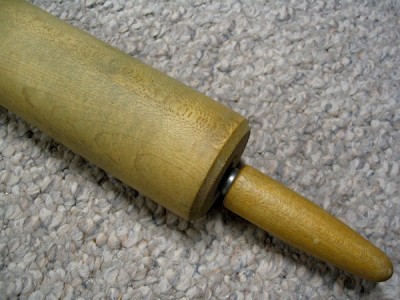
How old is it?
As with the wood’s source, its age will also help in identification purposes. Not only will it help to determine if the wood should have developed a natural patina, but it will also suggest certain species which were more prevalent at different times in history. For instance, many acoustic guitars made before the 1990s have featured Brazilian rosewood backs/sides, yet due to CITES restrictions placed upon that species, East Indian rosewood became a much more common species on newer guitars. (And this is a continuing shift as newer replacements are sought for rosewoods altogether.)
How large is the piece of wood?
Some species of trees are typically very small—some are even considered shrubs—while others get quite large. For instance, if you see a large panel or section of wood that’s entirely black, chances are it’s either painted, dyed, or stained: Gaboon ebony and related species are typically very small and very expensive.
What is the wood’s intended use?
Simply knowing what the wood was intended for—when considered in conjunction with where it came from and how old it is—can give you many clues to help identify it. In some applications, certain wood species are used much more frequently than others, so that you can make an educated guess as to the species of the wood based upon the application where it was used. For instance, in the United States: many older houses with solid hardwood floors have commonly used either red oak or hard maple; many antique furniture pieces have featured quartersawn white oak; many violins have spruce tops; many closet items used aromatic red cedar, and so forth. While it’s not a 100% guarantee, “profiling” the wood in question will help reduce the number of possible suspects, and aid in deducing the correct species.
6. Find the X-Factor.
Sometimes, after all the normal characteristics of a sample have been considered, the identity of the wood in question is still not apparent. In these instances—particularly in situations where a sample has been narrowed down to only a few possible remaining choices—it’s sometimes helpful to bring in specialized tests and other narrower means of identification.
The following techniques and recommendations don’t necessarily have a wide application in initially sorting out wood species and eliminating large swaths of wood species, but will most likely be of use only as a final step in special identification circumstances.
Odor
Believe it or not, freshly machined wood can have a very identifiable scent. When your eyes and hands can’t quite get a definitive answer, sometimes your nose can. Assuming there is no stain, finish, or preservative on or in the wood, quickly sand, saw, or otherwise machine a section of the wood in question, and take a whiff of the aroma.
Although new scents can be very difficult to express in words, many times the scent of an unknown wood may be similar to other known scents. For instance, rosewoods (Dalbergia spp.) are so named for their characteristic odor that is reminiscent of roses. Although difficult to directly communicate, with enough firsthand experience scents can become a memorable and powerful means of wood identification.
Fluorescence
While certain woods can appear basically identical to one another under normal lighting conditions, when exposed to certain wavelengths—such as those found in blacklights—the wood will absorb and emit light in a different (visible) wavelength. This phenomenon is known as fluorescence, and certain woods can be distinguished by the presence or absence of their fluorescent qualities. See the article Fluorescence: A Secret Weapon in Wood Identification for more information.
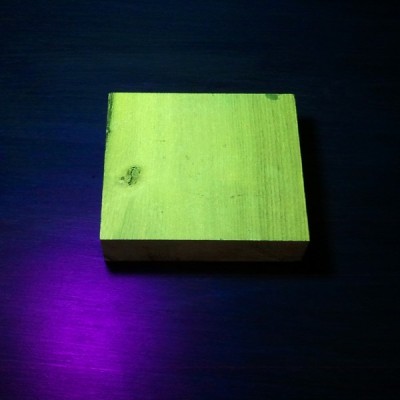
Chemical Testing
There are only a small number of chemical tests regularly used on wood, most of which are very specialized and were developed to help distinguish easily confused species with one another. They work by detecting differences in the composition of heartwood extractives. A chemical substance (called a reagent) is usually dissolved in water and applied to the wood surface: the surface is then observed for any type of chemical reaction (and accompanying color change) that may occur. Two of the most useful are the tests that are meant to separate Red and White Oak, and Red and Hard Maple.
Heartwood Extractives Leachability
Sometimes a wood species will have heartwood extractives that will be readily leachable in water and capable of conspicuously tinting a solution of water a specific color. For instance, the heartwood extractives contained in osage orange (Maclura pomifera) contain a yellowish-brown dye that is soluble in water. (This can sometimes be observed anecdotally when the wood is glued with a water-based adhesive: the glue’s squeeze-out is an unusually vibrant yellow.)
In a simple water extract color test, wood shavings are mixed with water in a vial, test tube, or other suitably small container, and the color of the water is observed after a few minutes. If the heartwood extractives are leachable by water, then a corresponding color change should quickly occur.
In addition to osage orange (Maclura pomifera), merbau (Intsia spp.), and rengas (Gluta spp. and Melanorrhoea spp.) are also noted for their readily leachable heartwood extractives. Because this property is quite uncommon, it can serve to quickly differentiate these woods from other lookalikes.
7. Look at the endgrain.
Perhaps no other technique for accurate identification of wood is as helpful and conclusive as the magnified examination of the endgrain. Frequently, it brings the identification process from a mostly intuitive, unscientific process into a predictable, repeatable, and reliable procedure.
Looking at the endgrain with a magnifier shouldn’t be a mystifying or esoteric art. In many cases, it’s nearly as simple as examining small newsprint under a magnifying glass. There are three components necessary to reap the full benefits contained in the endgrain:
I. A prepared surface.
When working with wood in most capacities, it becomes quickly apparent that endgrain surfaces are not nearly as cooperative or as easily worked as face grain surfaces. However, in this case, it is absolutely critical that a clear and refined endgrain surface is obtained.
For a quick glance of a softwood sample, a very sharp knife or razor blade can be used to take a fresh slice from the endgrain. However, in many denser species, especially in tropical hardwoods, one of the best ways to obtain a clear endgrain view is through diligent sanding. It’s usually best to begin with a relatively smooth saw cut (as from a fine-toothed miter saw blade) and proceed through the grits, starting at around 100, and working up to at least 220 or 320 grit, preferably higher for the cleanest view.
II. The right magnifier.
It need not be expensive, but whatever tool is used to view the endgrain should have adequate magnifying power. In most instances, 10x magnification is ideal, however, anything within the range of 8 to 15x magnification should be suitable for endgrain viewing. (Standard magnifying glasses are typically in the range of 2 to 4x magnification.)
These stronger magnifiers, sometimes called loupes, usually have a smaller viewing area than standard magnifying glasses. Fancier models—with built in lights, or larger viewing surfaces—are available at a premium; but the most basic models are usually only a few dollars.
III. A trained eye.
The third element that constitutes a proper endgrain examination is simply knowing what to look for. In analyzing the patterns, colors, shapes, and spacing of the various anatomical features, there is a veritable storehouse of information within the endgrain—all waiting to be unlocked. Yet, if these elements have not been pointed out and learned, the array of features will simply seem like an unintelligible jumble. The discipline of recognizing anatomical endgrain features is not easily summed up in a few sentences or even a few paragraphs, but it is nonetheless critical to the identification process. To this end, an in-depth look should be given to the various categories, divisions, and elements that constitute endgrain wood identification on the macroscopic level. (In this regard, macroscopic denotes what can be seen with a low-powered, 10x hand lens—without the aid of a microscope—rather than simply what can be seen with the naked eye.) Because the anatomy between softwoods and hardwoods is so divergent, each will be considered and examined separately:Still stumped?
If you have a mysterious piece of wood that you’d like identified, you’ve got a few options for next steps:USDA’s Forest Products Laboratory
You can mail your physical wood samples to the Center for Wood Anatomy Research.
Pros:
- Free
- Professional wood identification
Cons:
- Only available to US citizens
- Slow turnaround times (up to a month or more)
- Limited to three IDs per year
See their Wood ID Factsheet for more info.
Alden Identification Service
You can mail your physical wood samples (even small sections taken from antiques) to Alden Identification Service.
Pros:
- Professional wood identification
- Faster turnaround times (ranging from a few days to a week or two)
Cons:
- Paid service
See their ordering page for more info. (Note that Harry Alden has written several books while at USDA, including both Hardwoods and Softwoods of North America.)
Ask for help online
If the wood ID is merely a curiosity, or non-critical, you can post pictures of the wood in question.
Pros:
- Free
- No need to send physical samples
Cons:
- Greatly limited by the quality of the pictures provided
- Extra work usually required to get adequate clarity in photos
See article of Common US Hardwoods to help find the most commonly used woods.
Get the hard copy
 If you’re interested in getting all that makes The Wood Database unique distilled into a single, real-world resource, there’s the book that’s based on the website—the Amazon.com best-seller, WOOD! Identifying and Using Hundreds of Woods Worldwide. It contains many of the most popular articles found on this website, as well as hundreds of wood profiles—laid out with the same clarity and convenience of the website—packaged in a shop-friendly hardcover book.
If you’re interested in getting all that makes The Wood Database unique distilled into a single, real-world resource, there’s the book that’s based on the website—the Amazon.com best-seller, WOOD! Identifying and Using Hundreds of Woods Worldwide. It contains many of the most popular articles found on this website, as well as hundreds of wood profiles—laid out with the same clarity and convenience of the website—packaged in a shop-friendly hardcover book. 


Why I will no longer be replying to every wood ID request I’ve replied to literally thousands of wood ID requests on this site over the past 13+ years, but as the site’s popularity has grown, so has the time demands for ID on a daily basis. (Contrary to what some may seem to think, I am not some all-knowing wood wizard that can instantly ID your wood. It can actually take me a long time to sift through a lot of different resources.) Over the past few years, my backlog of pending wood species to be added to the… Read more »
I found this hardwood floor buried under a layer of carpet and a layer of veneer planks. My house was built in 1916 in Minneapolis, MN. I am just curious if anyone knows what kind of wood this is?
Can you attach pics, they didn’t come through.
Good evening. Any idea what this wood is? 1948 home. I was going to paint the steps, but after sanding, I found this cool looking wood grain… thanks!
Looks like a softwood species, possibly a hard yellow pine.
Thanks!
I wonder if you would be able to identify the wood in this chair? I believe it is old and likely from England. Thank you for your time.
Looks like I double posted this question. Sorry about that.
I would really appreciate any answer, I know they sometimes used two types of wood because the very hard woods would not bend into the balloon shape.
I can’t tell from the pics. The wood looks very non-descript without a lot of distinguishing features, and it has probably been at least lightly stained. Some possibilities might be maple or birch, but that is a very tentative guess.
I would like to know what kind of wood my chair is made from – I am in Canada but I am not sure where the chair originated. Any thoughts?
Hi I am about to refinish a table and 4 chairs. I just realized they are obviously different wood. Can you help me?
Thank you so much!
The chair bottom is beech, but I can’t tell what the table top is from that picture.
This is what the wood looks like after sanding down to the grain. Thank you so much for you help!
Can you retry attaching pic, it didn’t come through.
Any idea what this is? It’s the staircase in a house that I’ve just bought
Hi Eric. Any thoughts on what wood this is please?
Superficially, the color looks really similar to walnut. But I’m not familiar with what would be common in houses in UK. A clear closeup endgrain shot might possibly give more clues.
Trying to figure out if this is real wood, and if so, what type. Thanks in advance for your help.
Looks like stained red oak. Potentially veneer in some parts and solid in others, but still real.
Much appreciated… thank you!
Hello, it’s a old chair, and i’m doing a project about it and i just can’t figure what exactly is. I think its medium to light wood, isn’t that heavy.
Hello, please help with identifying the attached wood. The cupboard was probably made about 100 years ago in central Europe. Thank you in advance.
i found this at a woodworking please. can someone help identify it?i need it for a school project, thank you in advance
Looks like a Maple, possibly spalted.
My house was built in the 20s, the doors and trim all look like they’re made of the same wood. They’ve been thoroughly scratched over the years, so I am sanding them down and putting new stain on. Any idea what kind of wood it is from the photos? Two full doors are after sanding, and the other two closeups show the grain with a stain on it.
Please re-attach pics, they didn’t come through.
Hi I bought a swing of a certain type of wood but my father in-law said I did not get what I paid for. It has been treated with oil.
Thanks for your help identifying the wood in this table top. This is a custom made top, likely made on the west coast but found it’s way to Oregon, It’s about 1.25 inch thick and very heavy (also very big). It appears to have an oil finish.
hi, we are trying to identify our baseboards & door moldings. Probably installed late 70’s or during the 80’s. Couldn’t identify any distinctive wood odors after a light sanding. Attached pics of unstained side, sawn end, cracked end. Thanks
while no one has offered any comments on-line, someone else suggested to me this might be Hemlock? Any thoughts on that? thanks
Rick, for some reason, your initial pictures were extremely small so I couldn’t make out very much detail. But that first picture of the underside of the board looks a lot closer to a hardwood than a softwood. I can see what appears to be large open pores, which would rule out softwoods like hemlock. Maybe try reattaching larger/clearer pics.
What type of wood do you think this is? Part of an old chest that appears to be a blanket chest
Looks like southern yellow pine to me.
Thank you for any help you can provide identifying this. It’s from a late 60’s/early 70s end table that had been painted. I sanded the paint off, but am not good at identifying the wood.
Looks like a diffuse porous hardwood such as maple or birch.
Just purchased this home and trying to determine the wood type of these 70yr floors in Arkansas. Any thoughts?
Looks like southern yellow pine.
Hi I have a old VW camper I’m fixing up and the cabinets are completely ruined from water damage, I want to make new cabinets using hardwood plywood but don’t have a clue what type of wood they’re trying to mimic.
Thank you in advance
Looks like they are trying to mimic a roughsawn softwood species such as Douglas fir or southern yellow pine.
thank you very much
Are these floorboards also pine?
Also a softwood, possibly pine.
Thank you again, Eric
are These floorboards pine?
Yes, they appear to be a softwood of some sort, possibly pine. I’m not sure what’s commonly used in Scotland.
I own this office divider that I estimate to be from the 1940’s with ribbed glass partitions. The wood is core, not plywood or veneer. I’d love to identify the type of wood in this unique piece. Thanks!
This is a very heavy desk purchased in the early 50’s by my wifes grandfather in Ojai California. The desk was manufactured by Derby Desk of Boston, Massachusetts. It is very hard wood, my fingrrnail cannot scratch it at all. Thank you in advance for your help in identifying this wood species.
Michael Garofalo
Looks like quartersawn oak.
That would be white oak?
I can’t tell conclusively from the pic, but I’d at least lean more closely towards white rather than red.
Thank you vrry much for the help.
Hello! I am sanding my stairs and we need to find a stain that will go with our new white oak floors. My husband and I are trying to find what type of wood our stairs are. Its quite difficult ? Any ideas, it will really help! Thank you so much ?
Looks like red oak.
Sorry for the “?” in my previous msg.
I don’t know how they got there ?.
Your help is really appreciated thank you!
Are these floors Brazilian cherry? Thanks!
Those planks look more like black cherry, a domestic species, rather than Brazilian (which is not a true cherry and actually unrelated to cherry). The common name for Brazilian cherry outside of flooring circles is jatoba.
Hi Eric, do you know what type of wood this is? White oak or walnut veneer maybe? I’ve attached pictures of it originally and after I sanded it down a bit. Any idea? Thank you in advance for your help!
Yes, that’s oak. I can’t tell if it’s white or red from those pics though.
Thank you!
Making this into a end/coffee table. Where she bought they didn’t tell her the wood species and I am only good at telling walnut and pine. Any idea?
Please try to reattach pics, they didn’t come through.
Anyone know what type of wood this is? I think its a hardwood but its not really heavy like teak/oak etc. It’s not very light – I’d say average weight??? I’m thinking of using it as a ‘compression post’ to add structural support vertically with the grain… but don’t know what type of wood it is to check ‘crushing strength’. Any thoughts would be appreciated! Cheers, Ricky
Can you try reattaching the pic(s)? They didn’t come through.
Have to upload the pics individually
Have to upload the pics individually
Have to upload the pics individually!
Here the grain most reminds me of a Dracontomelon species, such as paldao or new guinea walnut. But I’ve only ever seen these woods for sale as veneer, not sold, so hard to say. Maybe Ireland has a different availability than North America.
I got it from a hardwood specialist that had went bust… a number of 10ft lengths, but had no idea of the specific type of hardwood. The photos on this website for Paldao definitely look the closest. It seems to have fairly decent structural capability – would it work as a vertical ‘stiffening’ support?
Paldao Crushing Strength: 6,990 lbf/in2 (48.2 MPa)
Hard to say for sure, but I would say that as long as the wood is free from major defects or highly irregular grain, that would go along way in ensuring at least decent performance.
A friend has suggested that this might be Meranti or possibly some type of Walnut. Either way, if its definitely a hardwood – will it have a high level of crushing strength to be used to provide vertical structural stability? Thanks!
The term “hardwood” is a term that simply denotes a tree that is an angiosperm (as opposed to a conifer), so it doesn’t necessarily guarantee any kind of strength level. Technically, even balsa is classified as a hardwood.
Can you tell me what wood this is?
Possibly Douglas fir, or another construction softwood.
Trying to determine what type of tree this wood is from
Not sure what type of wood this is
I have seen makore veneer with the same type of figure. Though it has possibly been dyed a darker brown, so it may be something else.
Hi Eric, I found a very unique dining table but I am not familiar with one of the woods used. I believe the thin inlay/banding is likely cherry or mahogany. The main wood on the trestle/legs appears to be satin wood. It is the wood that makes up the large band around the tabletop and the feet that I need help identifying. Thanks.
That is a pretty unusual pattern. I wonder if it is somehow a manmade product? Too bad we can’t see the endgrain of it anywhere. It looks a little suspicious to me, but I would love to be proven wrong.
Hello, Eric Meier,
Thank you for taking a look at this bowl. I wonder if you will please help me identify this wood?
Large wood pedestal bowl. 13.5 x 13.5 and 12 pounds
Appreciatively,
Mary
I’m sorry, I can’t tell from the pictures, especially since the grain seems to be greatly obscured by the pattern on the outside, as well as the dark colored stain covering large parts of the wood. Of note is that the turning incorporates the center pith portion of the wood, which isn’t a common feature for most turnings.
Thank you so much for your reply and sharing your expertise. It is a very kind gesture. Be well and take care.
Can someone PLEASE help me identify this type of wood? This footstool had a matching chair, handmade from 1940, in a cabin on Mt. Lemmon in the Santa Catalina mtns north of Tucson. It is extremely heavy, more so than any solid oak furniture I inherited from grandparents. Thought it might be mesquite because of the yellowish ring around outside. Really appreciate any input!! Thank you!
I’m sorry, I can’t tell from these pictures. I don’t know if they are just blurry, or don’t have enough light, or something else, but I can’t make out enough detail.
Any ideas on this desk I bought at an estate sale? It’s extremely heavy. The drawers are made with solid wood, but the outside appears to have a decorative veneer on it.
Drawer sides are made of oak, while the fronts are (probably) veneered mahogany.
Thank you! That was my guess as well. So helpful to have a second opinion. Appreciate you!
Ash
Hello,
I have a client that inherited this credenza and chairs from her grandmother and would like me to strip and stain to match a reclaimed table she purchased… She sent me these pictures. She’s not sure of the wood species. Alder? I want to be sure to know before I choose my stain. Thank you for any guidance!
Please retry attaching pics, they didn’t come through.
Second floor. First floor & stairs. Underside of first floor. (Sorry. These pictures go with my previous post asking about the type of wood)
At least some of those pictures look like southern yellow pine.
Thank you
Can you help me identify the wood type? The furniture itself is quite heavy.
I can’t tell from the pics, sorry. It’s possibly a basic diffuse porous hardwood like maple or birch.
Thank you for your answer. Here there are some closeups.
It doesn’t look familiar to me, sorry. It does look like a diffuse porous hardwood with fairly large open pores, so just by the size of the pores alone, that would rule out maple, birch, and poplar.
Looks like poplar
hi! Can you help me identify this wood? this is a bedroom suite that I purchased from a small unfinished wood furniture store in 2008. It was the only finished furniture in the store. The man said that the owner had it imported from India for himself but his wife hated it so he put it there to sell instead of using it. I was told that it was from a rare tree in India. It’s extremely heavy, I can’t even lift one nightstand by myself and it took 4 men to carry my dresser, headboard, and armoire inside, two… Read more »
I can’t tell for sure from the pics. One possibility that comes to mind is anjan. https://www.wood-database.com/anjan/
Here is a pic of the same tank where I shaved off a splinter
I can’t tell too much from the picture. It looks like a softwood, so you’d really have to get a clear look at the endgrain and look for resin canals and check scent.
I am about to leave reclaim the wood from these 80+ year old water tanks in South Georgia. Looks like Cyprus to me. Any ideas?
My partner started sanding this mission brown paint off this second hand bed and found this beautiful timber grain. It has old slotted screws and dowl joints. What do you think it is
Here are some better pictures
Based on your location and its weight, it could be one of the super dense species of Acacia that are native to Australia. https://www.wood-database.com/hardwoods/fabaceae/acacia/
Trying to match stairs to our rough cut deck. Any help identifying the wood would be greatly appreciated. I don’t know anything about types of woods so this is probably an easy one for you guys. Thanks!
It is an old-growth (or at least, with very tight grain) softwood. Even if I could tell the exact species (which I can’t), it would be much more important to match the growth rate and age of the tree, as most softwoods can look very similar. I would look for a softwood with tight grain to best match.
Thank you Eric! I will look for that when I contact my lumber guy.
I made a cutting board from scraps of wood in the workshop. I have no idea what the darker and olive colour wood with the stripes is. It was used as balusters in an outdoor deck. Thanks
Just a word of caution that exterior wood can sometimes be pressure treated with some pretty nasty chemicals (used to be arsenic), though I think copper is used nowadays. This preservative treatment is what gives the wood its greenish appearance (usually on pine or another softwood that will readily take in the preservative). I don’t think it would be a safe choice for use with food; I know it’s illegal in some areas to burn pressure treated wood because the ash is very dangerous.
Good Morning, can you please help me identify the wood in the attached? It was used by a previous owner to build an uncovered deck in 2018, so it has been in the elements for about 3 years (it has held up remarkably well). If it helps, I was told by the neighbor that the prior owner mentioned possibly importing an expensive Asian wood for the deck.
Sorry, the wood surface is too weathered in those pics for me to see much detail. But it does look like something imported, and not the usual run of the mill stuff like pine or cedar.
Made and purchased in Eugene Oregon 1978
The wood is fairly nondescript, so it’s hard to say for sure. It may simply be a basic veneer top such as birch.
Has a lot of grey grain in it. it was milled and planed down so its not weathered. It’s grain is tight and it sands smooth.
Looks a lot like maple to me.
Turns out it’s silver maple
Hi there, really enjoy this website! Here are two pics of wood we cannot identify. Any ideas? Thanks so much!
It could be something fairly basic like maple or birch.
hi there,
i purchased a dining set on FB market and I have just began the restoration process and have sanded it down. i’m not quite sure what wood this is and i want to make sure i use the proper stains and finish to protect this wood as much as possible.
thanks!
To me, it looks most like rubberwood. https://www.wood-database.com/rubberwood/
It’s very common on imported (and stained) furniture sets, especially in the past 10-20 years or so.
Can you help me identify this wood by the end grain. This time I was able to get the pictures attached.
To me, the closest match would be honey locust.
Hi. I recently purchased a wood cabinet online that I’m waiting to receive but the species was not listed. Can you point me in the right direction? Also, can you mention what wood species would compliment this specific wood furniture?
It doesn’t look like a domestic hardwood, though the wood color, especially the top, looks to be stained to resemble black walnut. Possibly an Asian tropical hardwood of some sort.